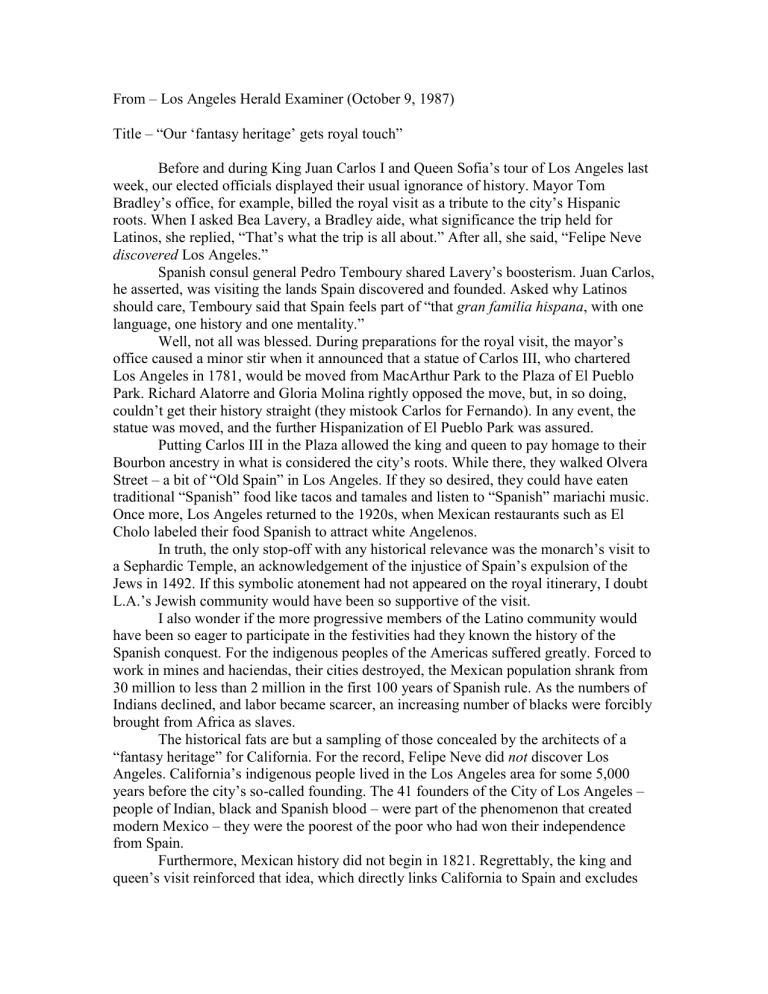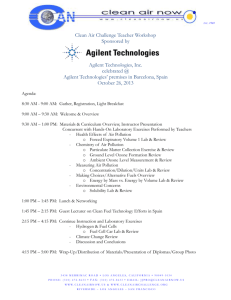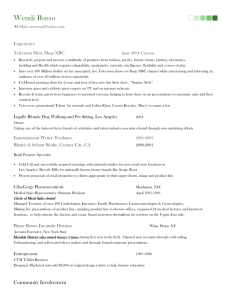1987 10-9 Herald Examiner-Our fantasy heritage gets royal touch

From – Los Angeles Herald Examiner (October 9, 1987)
Title – “Our ‘fantasy heritage’ gets royal touch”
Before and during King Juan Carlos I and Queen Sofia’s tour of Los Angeles last week, our elected officials displayed their usual ignorance of history. Mayor Tom
Bradley’s office, for example, billed the royal visit as a tribute to the city’s Hispanic roots. When I asked Bea Lavery, a Bradley aide, what significance the trip held for
Latinos, she replied, “That’s what the trip is all about.” After all, she said, “Felipe Neve discovered Los Angeles.”
Spanish consul general Pedro Temboury shared Lavery’s boosterism. Juan Carlos, he asserted, was visiting the lands Spain discovered and founded. Asked why Latinos should care, Temboury said that Spain feels part of “that gran familia hispana , with one language, one history and one mentality.”
Well, not all was blessed. During preparations for the royal visit, the mayor’s office caused a minor stir when it announced that a statue of Carlos III, who chartered
Los Angeles in 1781, would be moved from MacArthur Park to the Plaza of El Pueblo
Park. Richard Alatorre and Gloria Molina rightly opposed the move, but, in so doing, couldn’t get their history straight (they mistook Carlos for Fernando). In any event, the statue was moved, and the further Hispanization of El Pueblo Park was assured.
Putting Carlos III in the Plaza allowed the king and queen to pay homage to their
Bourbon ancestry in what is considered the city’s roots. While there, they walked Olvera
Street – a bit of “Old Spain” in Los Angeles. If they so desired, they could have eaten traditional “Spanish” food like tacos and tamales and listen to “Spanish” mariachi music.
Once more, Los Angeles returned to the 1920s, when Mexican restaurants such as El
Cholo labeled their food Spanish to attract white Angelenos.
In truth, the only stop-off with any historical relevance was the monarch’s visit to a Sephardic Temple, an acknowledgement of the injustice of Spain’s expulsion of the
Jews in 1492. If this symbolic atonement had not appeared on the royal itinerary, I doubt
L.A.’s Jewish community would have been so supportive of the visit.
I also wonder if the more progressive members of the Latino community would have been so eager to participate in the festivities had they known the history of the
Spanish conquest. For the indigenous peoples of the Americas suffered greatly. Forced to work in mines and haciendas, their cities destroyed, the Mexican population shrank from
30 million to less than 2 million in the first 100 years of Spanish rule. As the numbers of
Indians declined, and labor became scarcer, an increasing number of blacks were forcibly brought from Africa as slaves.
The historical fats are but a sampling of those concealed by the architects of a
“fantasy heritage” for California. For the record, Felipe Neve did not discover Los
Angeles. California’s indigenous people lived in the Los Angeles area for some 5,000 years before the city’s so-called founding. The 41 founders of the City of Los Angeles – people of Indian, black and Spanish blood – were part of the phenomenon that created modern Mexico – they were the poorest of the poor who had won their independence from Spain.
Furthermore, Mexican history did not begin in 1821. Regrettably, the king and queen’s visit reinforced that idea, which directly links California to Spain and excludes
Mexico. As one L.A. Mexican consular official put it, “It is as if North Americans want to purge the word Mexican; as if Mexican history did not exist.”
Or as a Mexican official said: “North Americans want to rewrite history and separate Latin Americans from their indigenous past. Take, for instance, the North
American’s use of the term Hispanic. Don’t they know that it comes from
Hispania , the
Roman word for Spain; Hispani means people from Spain.”
What is particularly irritating is that the Spaniards, while they are ready to atone for the expulsion of the Sephardic Jews, still do not understand how adversely their conquest and colonialization affected Mexicans of all racial backgrounds. Only last year, during a celebration of Columbus Day, Juan Carlos naively asserted that “We [Spain] opened the way for the most fertile social and cultural transformation in the history of mankind.” And while in the Bay Area last week, the king called the colonialization of
California Spain’s greatest single achievement in history.
These statements, among others, reflect a Euro-American bias: Humankind is limited to Western Europe; civilization is limited to the borders of Europe; non-whites haven’t suffered holocausts.
Miguel Leon Portilla, the distinguished Mexican pre-Columbian scholar, tells an anecdote that underscores this European ignorance of the pre-Columbian civilizations of the Americas:
A Spanish conquistador sat reading a book when a Nahuatl-speaking Indian approached him. Looking at what he was reading the Indian asked, “You also have books?”
The Aztecs, Mayas and other Mexican and Central American civilizations had codices (books) long before the coming of the Spaniards. They discovered the concept of zero in 200 B.C., a thousand years before the Arabs gave the idea to the Europeans.
Moreover, the indigenous peoples of California lived better before Spain, by force of arms, extended its empire to California.
In all probability, the Hispani of Los Angeles will vehemently deny this. Many
U.S. Cubans insist on the purity of their Spanish blood, overlooking the fact that in the 30 years following Spain’s conquest of Cuba, more than a million Indians were wiped out.
Some middle-class Mexican-Americans may fantasize that they are Spanish, and have a king and queen. As for me, I demand the same respect as shown by the Sephardic Jews.
The role Europe played in the destruction, not the discovery, of the Americas should no more be forgotten than the 1492 expulsion of the Jews. To forget that is tantamount to denying the Holocaust.









